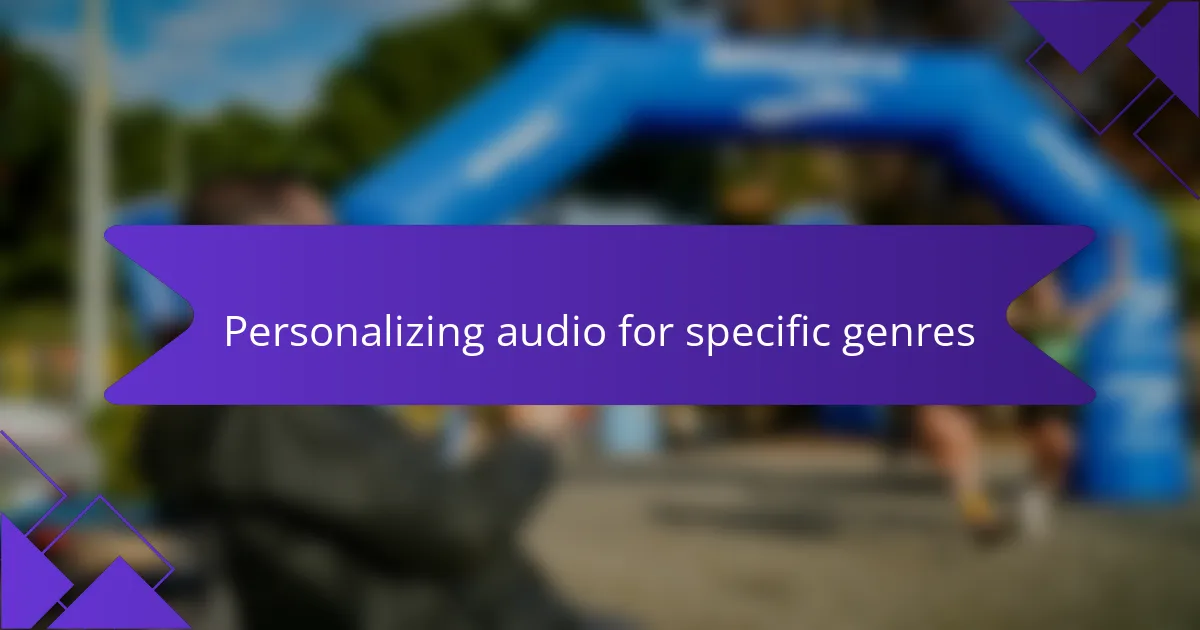Key takeaways
- Understanding key features of an audio mixer, such as faders and EQ controls, is crucial for achieving a high-quality sound experience as a DJ.
- Properly adjusting audio settings can enhance audience engagement and prevent technical issues during performances.
- Personalizing audio settings for different genres, like emphasizing bass for house music or enhancing clarity for trance, can evoke strong emotional responses from the crowd.
- Monitoring levels and using headphones for cueing are essential practices to maintain optimal sound quality and ensure smooth transitions during a set.

Understanding audio mixer basics
When I first started DJing, I quickly realized that understanding the basics of an audio mixer is essential for creating the right sound. An audio mixer allows you to blend multiple audio sources, control volume levels, and adjust the overall sound profile. For me, getting familiar with features like the EQ settings, faders, and the gain knob made a significant difference in my performances.
One of the key elements I love using is the equalizer (EQ), which allows me to fine-tune the frequency ranges of my tracks. For example, boosting the bass can add energy to the dance floor, while cutting mids can help clarity in vocals. I remember one night when I adjusted my EQ settings just in time and witnessed the crowd explode with energy—it’s moments like these that highlight how important these tools are.
Let’s take a closer look at how different audio mixer features compare in a simple table format.
| Feature | Description |
|---|---|
| Faders | Control the volume level of each audio channel. |
| EQ | Adjust frequency ranges (bass, mid, treble) to enhance sound quality. |
| Gain knob | Adjusts the input level of your audio sources to avoid clipping. |

Importance of audio settings
When it comes to audio settings, the difference they make in a live environment is nothing short of transformative. Imagine starting a set with poorly adjusted audio—distorted sound can drain the energy in the room faster than you can hit the next cue. I’ve been there, and let me tell you, a well-balanced mix not only enhances the listening experience but also engages the audience on a deeper level.
Fine-tuning the audio settings allows for a connection that can turn a good night into an unforgettable one. I recall a time when I lowered the treble just right, and all at once, the room felt full and inviting. It’s astonishing how small adjustments can create such significant emotional responses. Isn’t it amazing to think that the power of sound is directly tied to how effectively we manipulate these settings?
Proper audio settings can also prevent technical issues that might arise during a set. I once forgot to adjust the gain properly, and the result was feedback—a DJ’s nightmare! The importance of these settings can’t be overstated; they play a critical role in not only the quality of sound but also the overall mood of the event.

Key features of a mixer
A mixer is truly the heart of a DJ’s setup, acting as the control center for sound manipulation. In my experience, understanding the key features of a mixer can either make or break a performance. I’ve had nights where a simple adjustment on the EQ (Equalization) brought the crowd to life, making me feel the energy surge around the dance floor.
Here are some key features to consider when evaluating a mixer:
- Faders: These allow for smooth volume adjustments between channels. I always appreciate responsive faders for seamless transitions.
- EQ Controls: These enable you to adjust the bass, mid, and treble frequencies. I’ve found that mastering EQ settings can significantly improve sound quality.
- Gain Controls: They help manage the input levels of each channel. I’ve learned that tweaking gain can prevent distortion and ensure clarity.
- Effect Sends/Returns: Essential for adding effects like reverb or delay. It’s amazing how adding a hint of reverb can transform a track’s vibe.
- Cue Function: This lets you pre-listen to a track before mixing it live. It saves me from unpleasant surprises during a set.
These features not only enhance the mixing experience but also enrich my connection with the audience, creating unforgettable moments together.

Steps to adjust basic settings
When adjusting the basic settings of my mixer, I typically start with the gain knob. Setting the gain properly is crucial because it determines how much signal I’m getting from each source without distorting the sound. I remember an early gig where I didn’t set the gain correctly, and it ruined the whole vibe. Have you ever been in a situation where technicalities sabotaged your performance? It’s moments like that that make you realize the impact of a simple adjustment.
Next, I tackle the faders. Balancing the volume levels between channels is like crafting a beautiful piece of music; each element needs to complement the others. For me, I’ve found that slowly raising or lowering the fader, while listening intently to the mix, can help create a more dynamic sound. I often look out at the crowd, and if I see them moving with the music, I know I’ve struck the right balance.
Lastly, I get into the EQ settings. This is where some magic happens because it allows me to shape the sound to fit the atmosphere. I often experiment with boosting the bass or cutting the highs, depending on the energy of the crowd. I once played at an outdoor festival, and adjusting the EQ in real-time helped the music cut through the noise of the wind. Capturing those moments when the crowd connects with the sound is what it’s all about. Have you ever felt that thrill of getting your settings just right? It’s exhilarating!

Personalizing audio for specific genres
When it comes to personalizing audio for specific genres, I’ve learned that each style has its unique signature sound. For instance, when I play house music, I tend to emphasize the bass to create that deep, driving rhythm that gets everyone moving on the dance floor. I remember a night when I cranked up the low frequencies just right; the energy in the room instantly transformed, and it felt like the bass was pulsing through our hearts—an unforgettable connection.
On the flip side, playing a more melodic genre, like trance, often calls for a different approach. Here, clarity is paramount, and I find myself adjusting the highs to bring out those ethereal synths and layered vocals. It’s fascinating how this subtle tweak can evoke such powerful emotions. Have you ever noticed how certain sounds can transport you back to a specific moment in time? I certainly have, and that’s why I pay close attention to how I shape each track depending on the genre.
Another example that stands out for me is in hip-hop sets, where vocal clarity is essential. I’ve found that cutting some of the lower mids often makes the lyrics shine through, ensuring that everyone can vibe with the message. One night, I adjusted the mixer in real time between verses, and the crowd responded with excitement as they caught every word—it’s that kind of magic that fuels my passion for DJing. Wouldn’t you agree that mastering these audio nuances makes the experience not just about the music but about creating memories?

Tips for optimal sound quality
When it comes to achieving optimal sound quality on my mixer, I always pay close attention to the EQ settings. A well-balanced equalization can make a world of difference, ensuring that the highs, mids, and lows are perfectly blended. I recall a night when tweaking the bass slightly transformed the entire vibe of the dance floor; it felt electric.
Another crucial aspect is monitoring levels through the mixer’s meters. I find that keeping an eye on these levels can prevent distortion and keep the sound clear. There have been times when I got carried away with the volume during a particularly energetic set, only to realize I needed to dial it back to maintain that crisp audio quality that keeps the crowd engaged.
I also recommend using headphones to cue tracks and ensure they match the main output without any unpleasant surprises. I remember a gig where a last-minute headphone check saved me from a potentially awkward transition, and it reinforced how essential this practice is for any DJ looking to deliver a smooth sound experience.
| Tip | Details |
|---|---|
| EQ Settings | Balance highs, mids, and lows for clarity. |
| Monitoring Levels | Keep an eye on meters to avoid distortion. |
| Headphone Use | Always cue tracks in headphones for smooth transitions. |

Troubleshooting common audio issues
When troubleshooting common audio issues, I often find myself dealing with feedback, distortion, or unwanted noise. I’ve learned that adjusting EQ settings can make a significant difference. If feedback occurs, lowering the mid and high frequencies usually helps, while boosting the bass can fill out the sound without overwhelming it.
Distortion often pops up when the signal level is too high. In such cases, I recommend checking the gain levels and making sure they’re not peaking. I remember one gig where I hurriedly boosted the gain, and the sound turned into a chaotic mess—I had to quickly dial it back, and it was a valuable learning moment.
Here’s a comparison of common audio issues and effective solutions:
| Audio Issue | Solution |
|---|---|
| Feedback | Lower mid and high frequencies |
| Distortion | Check and adjust gain levels |
| Unwanted Noise | Use noise gates or check cables |



